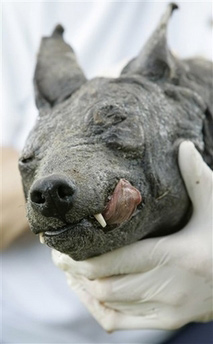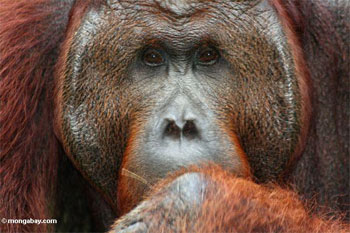Chupacabra story is a hoax; likely a Xolo dog breed
Rhett A. Butler, mongabay.com
September 4, 2007
[DNA analysis: coyote (Nov 1, 2007)]
An alleged chupacabra carcass found in Texas is likely a hoax to sell T-shirts say dog experts.
The animal, described in an Associated Press report last week as “a cross between two or three different things”, was found as road kill last month near the Texas town of Cuero. The woman who discovered the carcass has been using it to market chupacabra T-shirts.
In lively Internet discussions dog breeders say the carcass appears to be that of a Xoloitzcuintle or Xolo, otherwise known as a Mexican Hairless dog, rather than the blood-sucking creature of legend.
“The overwhelming consensus on the Xolo discussion list — which includes several hundred people — is that this animal is a Xolo,” said a top dog breeder who declined to be identified. “The dog looks like it has Xolo genetics. This is not a chupacabra — that’s absurd.”
“This animal has the correct skull for a Xolo and it obviously has the hairless genetics,” the breeder told mongabay.com. “It could be half Xolo or could be a pure bred. What is certain from the photos is that this was a very unhealthy individual. There are signs of poor nutrition and possibly problems with parasites. It is a very scruffy-looking Xolo. It’s very sad.”

Frozen head of a so-called Chupacabra in Cuero, Texas. (AP Photo/Eric Gay). In the past some have claimed coyotes with mange and deformed dogs as chupacabra and other mythological animals. |
The breeder says the animal may have doctored to make it look more menacing.
“From the photo you can’t tell if the canines have been extended or whether they are natural teeth attached to the upper jawbone of the animal,” the breeder continued. “There are so many fabrications these days that when people see a photo on the Internet they have to wonder what is real. In this case the teeth could have been shoved into the upper jaw. That said, some Xolos have very substantial canines.”
The breeder says that instead of debating whether the animal is a mythological beast, the focus should be on how the animal came to be in this condition and why it died.
“The focus has been very distorted. People should be interested in what these animals really are and their well-being — why they died, why this is happening,” the breeder said. “I believe it’s more of an issue of animal neglect or possible abuse than it is chupacabras wandering in from the bush.”
“What we’re dealing with is an animal problem. The answers should be coming from people who are qualified to examine these remains and tell us what they are and why they died. Were they poisoned? Are they diseased? Are other animals at risk? Could there be a Xolo breeder in the area who wanted to dump some dogs? It has certainly happened in other parts of the country.”
Another Xolo owner says that dumping and neglect is a serious concern.
“What may be most disturbing is that three of these Xolos were found as “road kill”, and Xolos are very, very uncommon – and not feral in the US!,” said Claire, a member of the Xolo group. “This suggests to me that someone is breeding Xolos and dumping ‘undesirable’ dogs.”
A local veterinarian who has seen the carcass doubts that the animal is anything noteworthy.
“I’m not going to tell you that’s not a chupacabra… in my opinion a chupacabra is a dog,” Travis Schaar of the Main Street Animal Hospital in nearby Victoria told the Associated Press.
The breeder adds that periodic reports of chupacabra and other mythological beasts probably do more harm than good.
“These cases over the years seem to always involve a known animal — either domestic or wild — ranging from domestic dog breeds to coyotes to foxes,” the breeder said. “These animals are often diseased, malnourished, or abused. Now we have people shooting these animals on site, manipulating their corpses, and calling them fantastic beasts. We need to bring people’s attention to the real issues: abuse, neglect, and unscrupulous breeders.”
The legend of the chupacabra dates back to 1987 when Puerto Rican newspapers El Vocero and El Nuevo Dia reported on mysterious deaths of animals which were said to have been drained of blood. Its name, coined by Puerto Rican comedian Silverio Pérez, translates to “goat sucker.” The mythological beast is sometimes blamed for the disappearance and loss of goats, chickens and other farm animals.
More articles

|
Rare Chinese river dolphin sighting in question
(08/31/2007) A prominent researcher is skeptical of last week’s reported sighting of the baiji, the Chinese river dolphin declared extinct earlier this year, according to the New York Times. The sighting near Tongling city in Anhui Province — widely reported in Chinese and Western media — was captured on video. Dr. Robert L. Pitman of the National Oceanic and Atmospheric Administration’s Fisheries Ecosystem Studies Program said Chinese scientists question that the video shows a baiji at all.
Python explodes after swallowing 6-foot alligator in Florida Everglades
(10/5/2006) The National Park Service released photos that show the carcass of an American alligator that was almost swallowed by a Burmese python. Park officials discovered the animal carcasses in a remote part of Everglades National Park, in south Miami-Dade, Florida, on Monday, Sept. 26, 2005. It appears that the 13-foot long Burmese python attempted to swallow the six-foot alligator before its stomach ruptured, resulting in the deaths of both animals.
